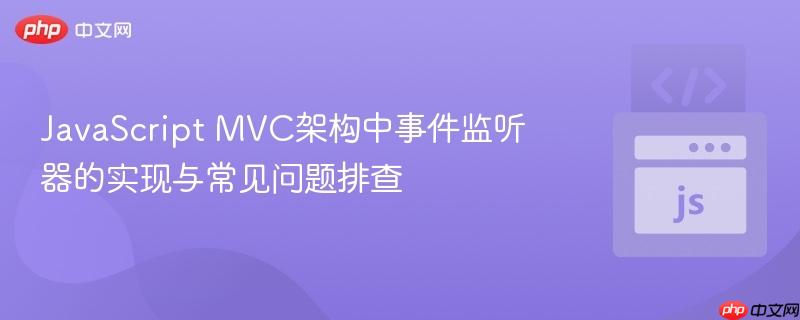
本文详细阐述了在javascript mvc架构中如何高效实现事件监听器,重点分析了视图层事件注册与控制器层处理函数绑定过程中可能出现的无响应问题。文章将提供清晰的代码示例、调试技巧及最佳实践,旨在帮助开发者构建健壮的事件驱动型应用。
引言:MVC架构中的事件流
在JavaScript的MVC(Model-View-Controller)架构中,事件监听器是实现用户界面交互的核心机制。通常,视图(View)负责渲染ui元素并监听用户输入事件(如点击、键盘输入),而控制器(Controller)则负责响应这些事件,并协调模型(Model)和视图之间的交互。这种模式下,视图充当事件的“发布者”,控制器充当事件的“订阅者”,通过回调函数实现解耦。
用户提供的代码片段正是这种模式的典型体现:
- 视图层 (view.js): 包含一个nextQuestion函数,它负责获取dom中的.next-btn元素,并为其添加一个事件监听器。这个监听器接收一个handler函数作为回调,当按钮被点击时执行。
- 控制器层 (controller.JS): 包含一个init函数,它导入视图层的nextQuestion函数,并传入一个名为showQuestion的回调函数(假设showQuestion是控制器或模型层定义的一个处理逻辑)。
// /////////// CONTROLLER ////////// // controller.js // import { nextQuestion } from './view.js'; // 假设已正确导入 // import { showQuestion } from './model.js'; // 假设 showQuestion 存在 // const init = function () { // nextQuestion(showQuestion); // }; // init(); // 直接调用 init // ///////////// VIEW ////////////// // view.js // export const nextQuestion = function (handler) { // const nextQuestionBtn = document.querySelector(".next-btn"); // nextQuestionBtn.addEventListener("click", handler); // };
从代码结构上看,这种实现方式在概念上是正确的。然而,当事件监听器未能按预期工作时,通常是由于一些常见的JavaScript运行时问题或执行时序问题导致的。
常见问题与排查策略
当上述事件监听机制未能奏效时,以下是几个最常见的排查点和相应的解决方案:
立即学习“Java免费学习笔记(深入)”;
1. DOM元素未加载完成
这是最常见的原因。当JavaScript代码执行时,如果其尝试获取的DOM元素(如.next-btn)尚未被浏览器解析和渲染到DOM树中,document.querySelector()将返回NULL。对null添加事件监听器自然不会有任何效果。
-
排查方法: 在nextQuestion函数内部,检查nextQuestionBtn是否为null。
// view.js export const nextQuestion = function (handler) { const nextQuestionBtn = document.querySelector(".next-btn"); if (!nextQuestionBtn) { console.error("Error: Element with class '.next-btn' not found in the DOM!"); return; // 提前退出,避免对 null 操作 } nextQuestionBtn.addEventListener("click", handler); console.log("Event listener for '.next-btn' attached."); }; -
解决方案: 确保在DOM内容完全加载后再执行事件绑定逻辑。推荐使用DOMContentLoaded事件,它会在html文档完全加载和解析完成后触发,而无需等待样式表、图片等资源。
// controller.js import { nextQuestion } from './view.js'; // ... 其他导入 ... const init = function () { console.log("Controller: init function is running."); // 确保在DOM准备好后才调用 nextQuestion nextQuestion(/* showQuestion */); }; // 将 init 函数的调用封装在 DOMContentLoaded 事件中 document.addEventListener('DOMContentLoaded', init); // 或者,如果您的 script 标签带有 type="module" 并且放置在 <body> 底部, // 通常也可以直接调用 init(),但使用 DOMContentLoaded 更保险。 // init(); // 如果 script 标签在 <body> 底部,且没有 async/defer 属性
2. 控制器初始化函数未被调用或调用时机不当
即使视图层的事件绑定逻辑正确,如果控制器中的init()函数没有被执行,或者在nextQuestion函数被调用时,nextQuestion模块没有被正确导入或其内部逻辑没有运行,事件绑定也不会发生。
-
排查方法: 在controller.js的init函数内部和view.js的nextQuestion函数内部添加console.log语句,观察它们是否按预期执行。
// controller.js const init = function () { console.log("Controller: init function is running."); // 调试信息 // ... nextQuestion(/* showQuestion */); }; // view.js export const nextQuestion = function (handler) { console.log("View: Attempting to attach nextQuestion event listener."); // 调试信息 const nextQuestionBtn = document.querySelector(".next-btn"); // ... if (nextQuestionBtn) { nextQuestionBtn.addEventListener("click", handler); console.log("View: Event listener attached to '.next-btn'."); } else { console.error("View: Element '.next-btn' not found."); } };通过观察控制台输出,可以判断是init函数没有执行,还是nextQuestion函数没有被调用,或是nextQuestion内部查找元素失败。
3. 模块导入或路径问题
确保controller.js正确地导入了view.js中的nextQuestion函数。错误的路径或命名会导致函数无法被找到,从而使nextQuestion调用失败。
- 排查方法: 检查import语句的路径是否正确,例如import { nextQuestion } from ‘./view.js’;中的./view.js是否指向正确的文件。确保导出的函数名与导入的函数名匹配。浏览器开发者工具中的网络(Network)标签页可以显示模块是否成功加载。
4. 元素选择器错误或元素不存在
确认HTML中确实存在一个类名为next-btn的元素,并且选择器是正确的。拼写错误、类名不匹配或元素压根不存在都会导致document.querySelector()返回null。
- 排查方法: 使用浏览器开发者工具(Elements标签页)检查DOM结构,确认是否存在一个具有class=”next-btn”的按钮元素。
最佳实践与完整示例
为了构建一个健壮的事件监听机制,我们结合上述排查点,提供一个完整的MVC事件流示例。
HTML结构 (index.html):
<!DOCTYPE html> <html lang="en"> <head> <meta charset="UTF-8"> <meta name="viewport" content="width=device-width, initial-scale=1.0"> <title>MVC Event Listener Demo</title> </head> <body> <div id="app"> <h1>Current Question: What is MVC?</h1> <button class="next-btn">Next Question</button> </div> <!-- 使用 type="module" 确保模块化加载 --> <script type="module" src="controller.js"></script> </body> </html>
Model模块 (model.js): 负责管理应用数据,例如问题列表。
// model.js const questions = [ "What is MVC?", "What is a Controller?", "What is a View?", "What is a Model?" ]; let currentQuestionIndex = 0; export const getNextQuestion = function() { currentQuestionIndex = (currentQuestionIndex + 1) % questions.length; return questions[currentQuestionIndex]; }; export const getCurrentQuestion = function() { return questions[currentQuestionIndex]; };
View模块 (view.js): 负责UI渲染和事件注册。
// view.js export const nextQuestion = function (handler) { const nextQuestionBtn = document.querySelector(".next-btn"); if (nextQuestionBtn) { nextQuestionBtn.addEventListener("click", handler); console.log("View: Event listener for '.next-btn' has been attached."); } else { console.error("View: Element with class '.next-btn' not found in the DOM."); } }; export const renderQuestion = function(questionText) { const h1 = document.querySelector('h1'); if (h1) { h1.textContent = `Current Question: ${questionText}`; console.log(`View: Rendered question: ${questionText}`); } else { console.error("View: H1 element for question not found."); } };
Controller模块 (controller.js): 协调Model和View,处理业务逻辑和用户交互。
// controller.js import { nextQuestion, renderQuestion } from './view.js'; import { getNextQuestion, getCurrentQuestion } from './model.js'; // 处理点击事件的函数,作为回调传给 View const controlNextQuestion = function () { console.log("Controller: 'Next Question' button clicked!"); const newQuestion = getNextQuestion(); // 从 Model 获取新数据 renderQuestion(newQuestion); // 更新 View }; // 初始化应用的函数 const init = function () { console.log("Controller: Application initialization started."); // 首次加载时显示当前问题 renderQuestion(getCurrentQuestion()); // 注册事件监听器,将控制器的方法作为回调传递给视图 nextQuestion(controlNextQuestion); }; // 确保在DOM完全加载后执行初始化函数 // 这是确保所有DOM元素都可用的最可靠方式 document.addEventListener('DOMContentLoaded', init);
通过这个完整的示例,我们可以看到:
- DOM就绪: document.addEventListener(‘DOMContentLoaded’, init); 确保了所有DOM操作都在DOM树构建完成后进行。
- 模块化: import和export语法清晰地定义了模块间的依赖和接口。
- 职责分离: View负责UI和事件注册,Model负责数据,Controller负责协调。
- 调试友好: 关键环节都加入了console.log,便于追踪代码执行流程和定位问题。
总结
在JavaScript MVC架构中实现事件监听器时,关键在于理解视图、控制器和DOM之间的交互时序。当遇到事件无响应的问题时,请系统地检查以下几点:
- DOM元素是否已加载: 确保在document.querySelector执行时,目标DOM元素已经存在于文档中。DOMContentLoaded事件是解决此问题的首选方案。
- 控制器初始化是否执行: 确认控制器中的init函数确实被调用,并且在正确的时机调用。
- 模块导入是否正确: 检查import语句的路径和函数名是否与export匹配。
- 元素选择器是否准确: 验证document.querySelector中的选择器是否能准确匹配到目标DOM元素。
通过遵循这些最佳实践和排查策略,您将能够更有效地在JavaScript MVC应用中实现和调试事件监听机制,构建出响应迅速、用户体验良好的Web应用。


